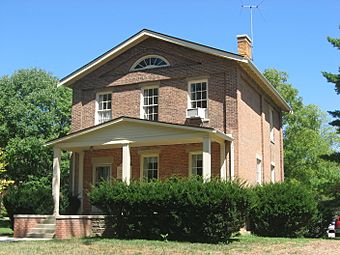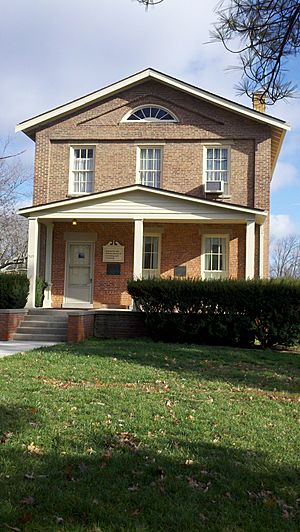Langstroth Cottage facts for kids
|
Langstroth Cottage
|
|

Front and side of Langstroth Cottage
|
|
| Location | 303 Patterson Avenue, Oxford, Ohio |
|---|---|
| Area | 0 acres (0 ha) |
| Built | 1858 |
| Architectural style | Greek Revival |
| NRHP reference No. | 76001378 |
Quick facts for kids Significant dates |
|
| Added to NRHP | June 22, 1976 |
| Designated NHL | December 21, 1981 |
Langstroth Cottage is a special old building in Oxford, Ohio. It's located on the Western College campus of Miami University. This cottage became a National Historic Landmark in 1976.
The cottage was built in 1856. It became famous because of a man named L. L. Langstroth. He was a very important beekeeper. Langstroth lived here for 28 years, starting in 1859. During that time, he studied and bred honey bees. Today, the cottage is used by the Butler County Regional Transit Authority.
Contents
Building History and Design
Langstroth Cottage was built in the mid-1850s. A man named Reverend Edward Root built it. In 1859, Lorenzo Langstroth's brother-in-law bought the house for him. Langstroth lived there with his family and continued his work with bees.
This cottage is the oldest building on the Western College campus. It's easy to spot near Patterson Avenue and State Route 27. This makes it a clear landmark for Miami University.
The cottage shows off a style called Greek Revival architecture. This design was popular around 1856. The house has been updated over time. It now has new oak floors and modern heating. The basement's wooden floors were replaced with concrete. The fireplaces are no longer used. But the outside walls of the house look much like they did originally.
The front of the house is very unique. It has brick pillars that hold up a triangular section called a pediment. This creates a special framed look. Each corner of the house has strong brick details. The side walls have a similar framed effect. This design is both pretty and smart. It's a rare sight in Oxford, Ohio. Above the front door, there's a cool, half-circle window. The rooms inside are simple but feel cozy. Langstroth also planted apple and American Linden trees around his home. These trees helped attract his beloved bees. He even had a large formal garden, almost an acre big, just for his bees.
How the Cottage Has Been Used
Over the years, Langstroth Cottage has served many purposes. It has been an academic building and a home for teachers.
The cottage was used by different programs at Miami University. This included the Miami University International Office. It also housed the Miami University Luxembourg Program Office. Right now, the cottage is used as office space. It helps with the public transportation for Miami University.
Lorenzo Lorraine Langstroth: The Father of Beekeeping
Lorenzo Langstroth grew up in Philadelphia, Pennsylvania. He was one of eight children. He went to Yale College and later studied to become a minister. He became a Presbyterian minister in Oxford.
Langstroth found his true passion in bees. He married Anne Tucker and they started a family. Langstroth faced health challenges throughout his life. He found great comfort and purpose in his bees. He even wrote a famous book called Langstroth on the Honeybee. This book shared all his amazing discoveries.
In his later years, Langstroth lived with his daughter in Dayton, Ohio. He passed away while giving a sermon in church. Langstroth is buried in Woodlawn Cemetery in Dayton. His gravestone proudly calls him "The Father of American Beekeeping."
Langstroth's Beekeeping Discoveries
Lorenzo Langstroth is known as the "Father of Beekeeping." He had a special way of understanding bees. He wrote many letters about his deep connection to them. He studied bee behavior and the equipment used to keep them. Langstroth saw problems with the old beekeeping tools. He knew he could find better solutions.
He wanted to improve the old Bevan bar hive. He found that the honeycombs couldn't be removed easily. Bees would fill small gaps with a sticky substance called propolis, or "bee glue." This made it hard to work with the hive.
Langstroth came up with a brilliant idea: the moveable bee-frame. This invention created a special "bee space." It was just enough room between the frames and the hive walls, bottom, and top. This space was too small for bees to build comb in, but too big for them to fill with propolis. This meant beekeepers could now easily remove and inspect the frames without harming the bees!
His moveable-frame beehive was patented in 1852. This invention changed beekeeping forever. Langstroth explained three big advantages of his new hive:
- Easy Inspection: Beekeepers could quickly and easily look at every honeycomb. The Langstroth hive was also cheap to make.
- Better Management: Beekeepers could now do many things. They could raise new queens or create new bee colonies. They could give honey to hungry hives. They could also collect honey in boxes or jars. This hive even helped protect against bee moths.
- Honey for Everyone: Farmers could easily get honey for their own families.
Langstroth believed that beekeeping was entering a "new era." He saw bees as amazing creatures. He famously said, "Tongues in trees, books in the running brooks, Sermons in 'bees,' and 'God' in every thing."
Italian Bees and Beekeeping Today
In 1859, Langstroth started bringing Italian Bees to America. He imported them from Jan Dzeirzon in Silesia. Langstroth and his son became very good at breeding Italian queen bees. They even sold them for twenty dollars each! These "twenty-dollar queens" became famous in America.
Langstroth bred these foreign bees with local ones. This changed the bees' color, behavior, and how much honey they made. Langstroth's bees became more obedient and worked harder. They produced more honey than ever before.
Today, the Oxford Community still celebrates beekeeping. They honor Langstroth's legacy with programs and events. In 1969, the Ohio State Beekeepers' Association Inc held a big meeting in Oxford. It had lectures, demonstrations, and films about beekeeping. There were also contests and tours of Miami University. In 2017, students at Miami University started the Miami Apiculture Society. This group continues Langstroth's tradition of beekeeping in Oxford.
National Landmark Status
Langstroth Cottage was the second building at Miami University to become a National Historic Landmark. To get this special title, a building goes through a few steps. First, experts study the building and visit it. Then, a committee evaluates it. Finally, the Secretary of the Interior approves the nomination.
Because the cottage is a National Landmark, it can get federal money. This money helps protect and preserve its history. A special marker outside the cottage tells its story. It says that Reverend Lorenzo Langstroth, "The Father of American Beekeeping," lived there from 1858 to 1887. The marker describes the cottage's Greek Revival style. It also mentions Langstroth's garden workshop. There, he made experimental hives and grew plants for his bees. He even shipped Italian queen bees all over the world from his home. The marker notes that Langstroth Cottage was added to the National Register of Historic Places in 1976. It became a National Historic Landmark in 1982.
Images for kids





